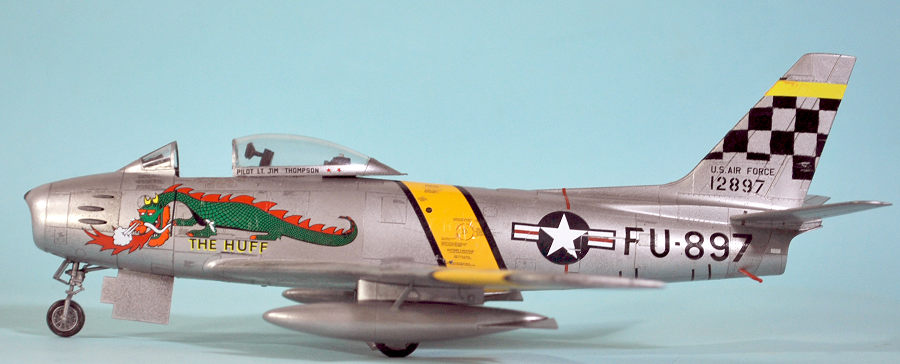
Hasegawa 1/48 F-86F Sabre
| KIT #: | 07072 |
| PRICE: | $ |
| DECALS: | One option |
| REVIEWER: | Tom Cleaver |
| NOTES: | Aires resin cockpit |

| HISTORY |
The F-86F Sabre, which first appeared in Korea in the fall of 1952, went a long way to beating the MiG-15 in performance areas where the Soviet fighter was superior to the earlier F-86A and F-86E Sabres. While the F-86F-1 and F-86F-5 were delivered with the same slatted “narrow chord” wing of the F-86E, when these fighters were refitted with the “6-3" leading edge extension in the spring of 1953 - which became factory-standard on the F-86F-10 - the Sabre was able to operate at 50,000 feet as did the MiG. The new wing also helped maintain the Sabre’s superior maneuverability at lower altitudes when flown at the higher altitudes necessary to combat the Mig. The cost was a higher landing speed than the earlier Sabres.
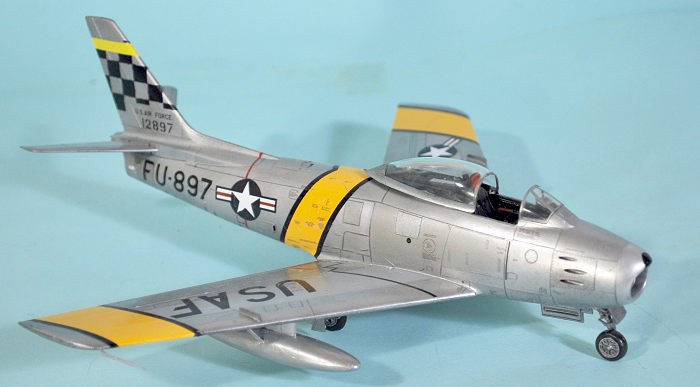 The
one shortcoming was continuing to use the six .50-caliber machine gun armament,
which was close to hopeless against the much-sturdier MiG-15. When Soviet Korean
War records became available for review in the mid-90s, it was found that 60% of
Sabre claims for shooting down a MiG-15 were inaccurate, with the enemy fighter
successfully returning to base; rather than a 10:1 victory edge, the real
victory ratio was more like 1.3:1 over the course of the war due to the
intelligence failure to learn how sturdy the MiG-15 was. Fifth Air Force began
awarding “kill” credits in 1953 based on gun camera footage that showed more
than 100 hits on a MiG; in truth, only hits around the tailpipe were generally
fatal, with the engine able to take multiple hits and keep running. The records
also showed that everr claim from the “Sabre Val” team in the 4th Fighter Wing
that flew Sabres specially armed with four 20mm cannon was valid. The Sabre Val
results in 1953 led to the USAF changing fighter armament from .50 caliber
machine guns to 20mm cannons on all gun armed fighters after the Sabre.
The
one shortcoming was continuing to use the six .50-caliber machine gun armament,
which was close to hopeless against the much-sturdier MiG-15. When Soviet Korean
War records became available for review in the mid-90s, it was found that 60% of
Sabre claims for shooting down a MiG-15 were inaccurate, with the enemy fighter
successfully returning to base; rather than a 10:1 victory edge, the real
victory ratio was more like 1.3:1 over the course of the war due to the
intelligence failure to learn how sturdy the MiG-15 was. Fifth Air Force began
awarding “kill” credits in 1953 based on gun camera footage that showed more
than 100 hits on a MiG; in truth, only hits around the tailpipe were generally
fatal, with the engine able to take multiple hits and keep running. The records
also showed that everr claim from the “Sabre Val” team in the 4th Fighter Wing
that flew Sabres specially armed with four 20mm cannon was valid. The Sabre Val
results in 1953 led to the USAF changing fighter armament from .50 caliber
machine guns to 20mm cannons on all gun armed fighters after the Sabre.
First Lieutenant Jim Thompson's F-86F "the Huff" is famous for being famously photographed with the most astounding nose art of any USAF fighter in Korea. Thompson, a wingman in the 39th FIS of the 51st FIW, shot down a PLAAF MiG-15 in May 1953 which had a very dramatic dragon painted on its nose. Returning to Suwon, Thompson convinced his Crew Chief to paint a dragon on his Sabre. With the wild painting on its nose, the airplane attracted photographers, and thus became famous. Thompson himself scored 2 victories by the end of hostilities in July 1953.
| THE KIT |
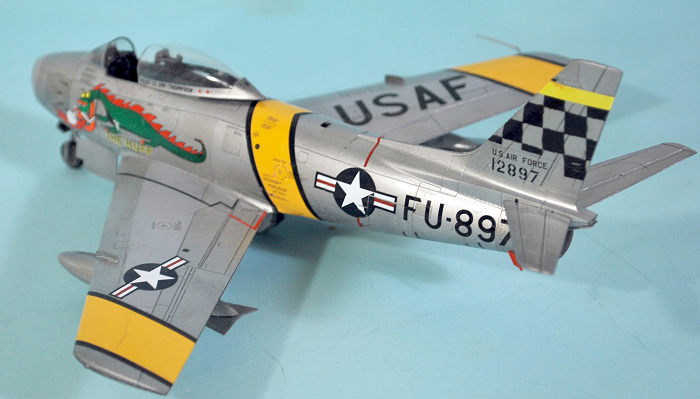 Hasegawa’s
limited release with these markings was released in 1997. This kit can be found
on eBay for prices around $75-$100 from collectors; I was able to pick this one
up at the LHS estate sale for $35, approximately the original price. Academy
released a kit with markings for “the Huff” in 2011, which is still available.
Kits in 1/72 with markings for “The Huff” include the Hobbycraft kit, the Airfix
F-86F, and the Fujimi kit. 21st Century Toys released a 1/18 F-86F with these
markings.Hasegawa’s limited release is considered ther best because the decals
are the most accurate; specifically, this is the only sheet that has the 51st
Fighter Wing checkerboard done “ragged” as is shown in period color photos of
the original airplane.
Hasegawa’s
limited release with these markings was released in 1997. This kit can be found
on eBay for prices around $75-$100 from collectors; I was able to pick this one
up at the LHS estate sale for $35, approximately the original price. Academy
released a kit with markings for “the Huff” in 2011, which is still available.
Kits in 1/72 with markings for “The Huff” include the Hobbycraft kit, the Airfix
F-86F, and the Fujimi kit. 21st Century Toys released a 1/18 F-86F with these
markings.Hasegawa’s limited release is considered ther best because the decals
are the most accurate; specifically, this is the only sheet that has the 51st
Fighter Wing checkerboard done “ragged” as is shown in period color photos of
the original airplane.
| CONSTRUCTION |
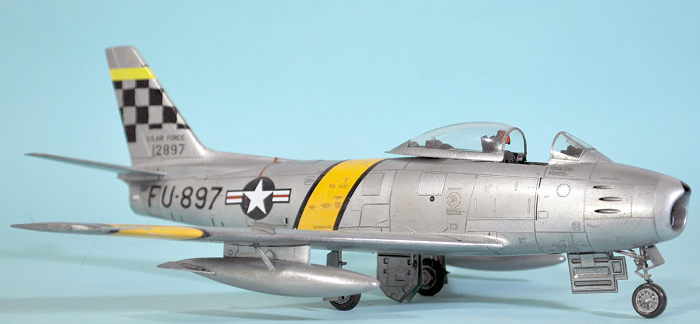 As is
frequently the case, the Aires resin cockpit did not fit the kit it was designed
for. I ended up using the kit-supplied plastic cockpit tub, with the excellent
Aires resin seat. In truth, the only aftermarket item any Sabre kit really needs
is a good seat, since it is so obvious under that big clear canopy.
As is
frequently the case, the Aires resin cockpit did not fit the kit it was designed
for. I ended up using the kit-supplied plastic cockpit tub, with the excellent
Aires resin seat. In truth, the only aftermarket item any Sabre kit really needs
is a good seat, since it is so obvious under that big clear canopy.
I squashed fishweights and crammed them into the area of the nose in front of the cockpit and above the intake trunking, and some more glued to the back of the cockpit tub. This gave the necessary weight to insure nose sitting.
| COLORS & MARKINGS |
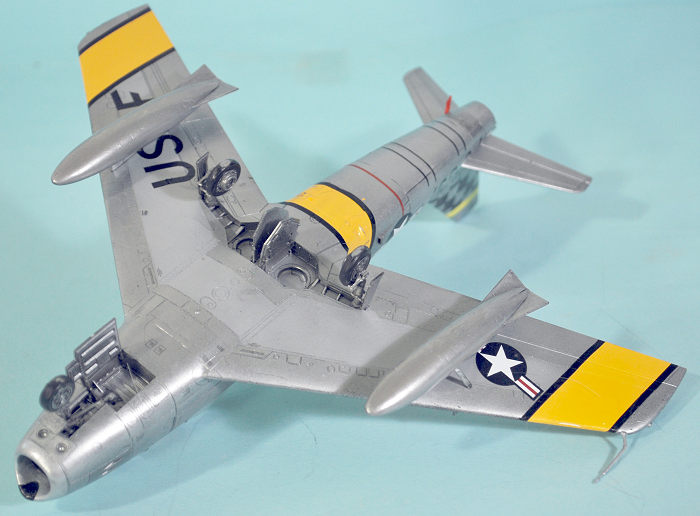 I
applied an overall primer coat of Tamiya “Semi-Gloss Black” X-18, misted on to
get a smooth surface, and painted the model with Vallejo mattalics. The primary
coat was “Aluminum.” I used “Dull Aluminum” with a brushful of Tamiya Gloss
White X-2 to “gray” the color, for the center area of the wing. “Semi-Matte
Aluminum” was used for the gun panels on the nose and the band at the rear of
the fuselage. “White Aluminum” was used for the nose cap, which was actually
made of plastic on the Sabre.
I
applied an overall primer coat of Tamiya “Semi-Gloss Black” X-18, misted on to
get a smooth surface, and painted the model with Vallejo mattalics. The primary
coat was “Aluminum.” I used “Dull Aluminum” with a brushful of Tamiya Gloss
White X-2 to “gray” the color, for the center area of the wing. “Semi-Matte
Aluminum” was used for the gun panels on the nose and the band at the rear of
the fuselage. “White Aluminum” was used for the nose cap, which was actually
made of plastic on the Sabre.
I used Warbirds Decals F-86F markings decal for the yellow ID stripes, the national insignia and the stencils. The individual aircraft markings came from the kit.
I attached the landing gear and drop tanks, unmasked the canopy and posed it open.
| CONCLUSIONS |
Anyone who reviews my built kits will easily conclude that the F-86 is my favorite jet. It’s high one the list of “modeler’s comfort food.” It looks good in any paint scheme or markings one wants to use. When it comes to the Hasegawa Sabre vs the Academy Sabre, the Academy wins out nowadays for being still available, while the Hasegawa kit - which I think is better on detail - is not generally available other than from dealers on eBay or a lucky find at the my Local Hobby Shop’s “estate sale” shelves (thanks to all of you guys who never got A Round Tuit and finished your collection of kits). Hasegawa’s habit of doing limited releases gives one other alternatives “in the box” and many of these were among the first Hasegawa decals to get rid of the ivory white option.
Review kit courtesy of all you book buyers.
8 February 2024 Copyright ModelingMadness.com. All rights reserved. No
reproduction in part or in whole without express permission. If you would like your product reviewed fairly and
fairly quickly, please
contact
the editor
or see other details in the
Note to
Contributors.